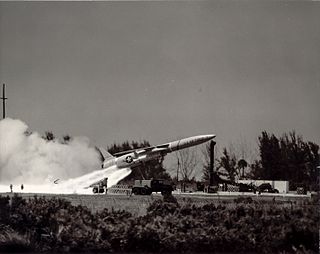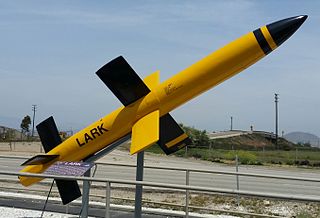| XSM-74 | |
|---|---|
| Type | Decoy missile |
| Production history | |
| Manufacturer | Convair |
| Specifications | |
| Mass | 5,000 lb (2,268 kg) to 7,500 lb (3,402 kg) |
| Length | 29 ft 5 in (9 m) |
| Warhead | None |
| Wingspan | 20 ft (6 m) to 25 (7.5 m) |
Operational range | 4,000 nmi (7,400 km) |
| Flight ceiling | 50,000 ft (15,200 m) |
| Flight altitude | 50,000 ft (15,200 m). |
| Maximum speed | Mach 0.80 to Mach 0.90 |
Launch platform | Zero-length ground launcher |
The Convair XSM-74 was a subsonic, jet-powered, ground-launched decoy cruise missile.
In March 1953, the United States Air Force released General Operational Requirement (GOR) 16 which called for a long range decoy missile to increase the effectiveness of Strategic Air Command bombers by confusing and saturating an air defense system. Multiple XSM-74 missiles would be ground-launched from Strategic Air Command bases located in the United States. Fifty percent of the deployed XSM-74 missiles would be launched within the first hour after an alert and the remaining missiles would be launched one hour later. The requirement called for 85 percent of the decoy missiles to arrive at the target area within 100 nmi (190 km). The XSM-74 was to fly 4,000 nmi (7,400 km) at speed of at least Mach 0.85 at an operating altitude of 50,000 ft (15,240 m) with a payload of 500 lb (227 kg). After flying 2,500 nmi (4,600 km), the XSM-74 would simulate the performance of the B-47 Stratojet or B-52 Stratofortress over the final 1,500 nmi (2,800 km) of flight.
Study contracts were awarded to Convair and Fairchild in July 1954 by the United States Air Force under the project designation MX-2223. According to USAF records, the designation XSM-74 was proposed for the MX-2223 missile, but never actually approved.
The Convair MX-2223 design called for a non-metallic fuselage with swept wings and a V-tail. Radar reflectors were located in the fuselage and on pods positioned on the wing tips to simulate the radar signature of a strategic bomber.
Development of the XSM-74 was suspended in December 1955 when Fairchild was awarded a contract by the USAF to develop the XSM-73 Goose.
Aircraft of comparable role, configuration, and era
Related lists

A cruise missile is a guided missile used against terrestrial or naval targets that remain in the atmosphere and flies the major portion of its flight path at an approximately constant speed. Cruise missiles are designed to deliver a large warhead over long distances with high precision. Modern cruise missiles are capable of traveling at high subsonic, supersonic, or hypersonic speeds, are self-navigating, and are able to fly on a non-ballistic, extremely low-altitude trajectory.
The SM-65 Atlas was the first operational intercontinental ballistic missile (ICBM) developed by the United States and the first member of the Atlas rocket family. It was built for the U.S. Air Force by the Convair Division of General Dynamics at an assembly plant located in Kearny Mesa, San Diego. Atlas became operational in October 1959, but was soon made obsolete as an ICBM by new development, and was retired from this role by 1965.

The Convair F-106 Delta Dart was the primary all-weather interceptor aircraft of the United States Air Force from the 1960s through to the 1980s. Designed as the so-called "Ultimate Interceptor", it proved to be the last specialist interceptor in U.S. Air Force service to date. It was gradually retired during the 1980s, with the QF-106 drone conversions of the aircraft being used until 1998 under the Pacer Six program.

Convair, previously Consolidated Vultee, was an American aircraft-manufacturing company that later expanded into rockets and spacecraft. The company was formed in 1943 by the merger of Consolidated Aircraft and Vultee Aircraft. In 1953, it was purchased by General Dynamics, and operated as their Convair Division for most of its corporate history.

The Northrop SM-62 Snark is an early-model intercontinental range ground-launched cruise missile that could carry a W39 thermonuclear warhead. The Snark was deployed by the United States Air Force's Strategic Air Command from 1958 through 1961. It represented an important step in weapons technology during the Cold War. The Snark was named by Jack Northrop and took its name from the author Lewis Carroll's character the "snark". The Snark was the only surface-to-surface cruise missile with such a long range that was ever deployed by the U.S. Air Force. Following the deployment of ICBMs, the Snark was rendered obsolete, and it was removed from deployment in 1961.

The Convair B-58 Hustler, designed and produced by American aircraft manufacturer Convair, was the first operational bomber capable of Mach 2 flight.

The Hughes AIM-4 Falcon was the first operational guided air-to-air missile of the United States Air Force. Development began in 1946; the weapon was first tested in 1949. The missile entered service with the USAF in 1956.

The AGM-86 ALCM is an American subsonic air-launched cruise missile (ALCM) built by Boeing and operated by the United States Air Force. This missile was developed to increase the effectiveness and survivability of the Boeing B-52H Stratofortress strategic bomber. The missile dilutes an enemy's forces and complicates air defense of its territory.

The Martin MGM-1 Matador was the first operational surface-to-surface cruise missile designed and built by the United States. It was developed after World War II, drawing upon their wartime experience with creating the Republic-Ford JB-2, a copy of the German V-1. The Matador was similar in concept to the V-1, but it included a radio command that allowed in-flight course corrections. This allowed accuracy to be maintained over greatly extended ranges of just under 1000 km. To allow these ranges, the Matador was powered by a small turbojet engine in place of the V-1's much less efficient pulsejet.

The AGM-129 ACM was a low-observable, subsonic, turbofan-powered, air-launched cruise missile originally designed and built by General Dynamics and eventually acquired by Raytheon Missile Systems. Prior to its withdrawal from service in 2012, the AGM-129A was carried exclusively by the US Air Force's B-52H Stratofortress bombers.

The Fairchild SM-73 was a sub-sonic, jet-powered, ground-launched decoy cruise missile.

The McDonnell ADM-20 Quail was a subsonic, jet powered, air-launched decoy cruise missile built by McDonnell Aircraft Corporation. The Quail was designed to be launched by the Boeing B-52 Stratofortress strategic bomber and its original United States Air Force designation was GAM-72.

The ADM-160 MALD is a decoy missile developed by the United States.
The FICON program was conducted by the United States Air Force in the 1950s to test the feasibility of a Convair B-36 Peacemaker bomber carrying a Republic F-84 Thunderflash parasite fighter in its bomb bay. Earlier wingtip coupling experiments included Tip Tow, which were attempts at carrying fighters connected to the wingtips of bombers. Tom-Tom followed the FICON project afterwards.

The Convair XGAM-71 Buck Duck was an air-launched decoy missile that was developed by Convair in the early 1950s. It was intended to have the same radar signature as the Strategic Air Command's B-36 bomber, thereby allowing it to disrupt the enemy's air defenses and dilute their effort to shoot down an incoming bomber fleet.

An air-launched ballistic missile or ALBM is a ballistic missile launched from an aircraft. An ALBM allows the launch aircraft to stand off at long distances from its target, keeping it well outside the range of defensive weapons like anti-aircraft missiles and interceptor aircraft. Historically, once launched the missile was essentially immune to interception due to a lack of capable anti-ballistic missiles, with those few that did exist being limited to known static positions. This combination of features allowed a strategic bomber to present a credible deterrent second-strike option in an era when improving anti-aircraft defences appeared to be rendering conventional bombers obsolete. However, by the 1990's surface-to-air missile technology had innovated to the point of allowing the interception of such weapons from road mobile systems, albeit at a lower PoK. By the early 21st century capable, dedicated, ABM systems from several nations had been deployed in significant numbers, spurring further innovation in hypersonic glide vehicles to penetrate such systems and keep ballistic missiles capable.
The Fairchild J83 turbojet was developed starting in 1955 to power cruise missiles used as un-armed decoys for bomber aircraft. The engine's development was terminated in November 1958.

The GAM-63 RASCAL was a supersonic air-to-surface missile that was developed by the Bell Aircraft Company. The RASCAL was the United States Air Force's first nuclear armed standoff missile. The RASCAL was initially designated the ASM-A-2, then re-designated the B-63 in 1951 and finally re-designated the GAM-63 in 1955. The name RASCAL was the acronym for RAdar SCAnning Link, the missile's guidance system. The RASCAL project was cancelled in September 1958.

The Lark project was a solid-fuel boosted, liquid-fueled surface-to-air missile developed by the United States Navy to meet the kamikaze threat. It was developed as a crash program to introduce a medium-range defensive layer that would attack targets between the long-range combat air patrols and short-range anti-aircraft artillery. This produced a design with roughly 30 miles (48 km) maximum range and subsonic performance, suitable for attacks against Japanese aircraft.